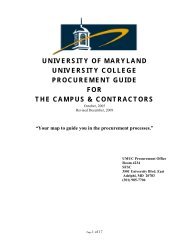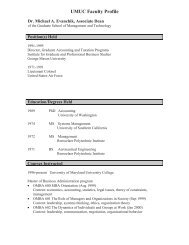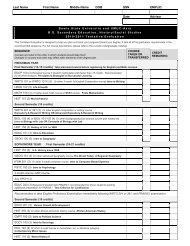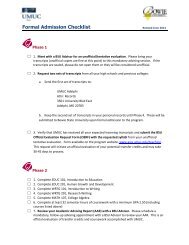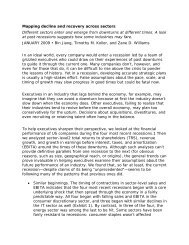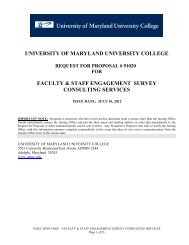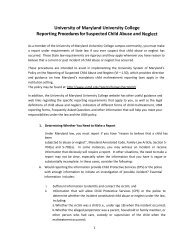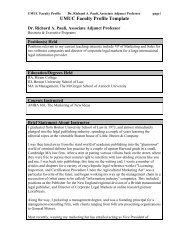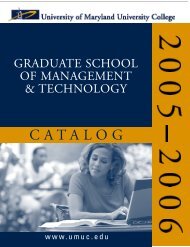A+B. Intro_SJ.1 - University of Maryland University College
A+B. Intro_SJ.1 - University of Maryland University College
A+B. Intro_SJ.1 - University of Maryland University College
Create successful ePaper yourself
Turn your PDF publications into a flip-book with our unique Google optimized e-Paper software.
IMAN 690 International Management Project (3)<br />
Prerequisite: Completion <strong>of</strong> all required and elective courses,<br />
including IMAN 650. Students demonstrate their ability to<br />
structure and complete a major project that identifies and<br />
resolves an important management or organizational issue.<br />
Students report the results <strong>of</strong> their efforts in written and oral<br />
form. The project may be developed in cooperation with students’<br />
current employers or with some organization <strong>of</strong> their<br />
choice, provided there is no conflict <strong>of</strong> interest. The project is<br />
conducted under the direction <strong>of</strong> an on-site supervisor in cooperation<br />
with a faculty advisor. Students have two semesters to<br />
complete the management project.<br />
ITSM 637 IT Acquisitions Management (3)<br />
This course defines management practices for the acquisition <strong>of</strong><br />
IT systems and information re s o u rces. St rong emphasis is placed<br />
on the importance <strong>of</strong> enterprise strategic planning and the concomitant<br />
IT strategic planning. Issues related to the deve l o p m e n t<br />
<strong>of</strong> the IT acquisition plan, financial planning and budgeting, integration<br />
<strong>of</strong> the proposed acquisition within the overall goals <strong>of</strong> the<br />
enterprise, and related IT program management are examined in<br />
the context <strong>of</strong> ove r a rching management challenges. Related issues<br />
include federal and commercial IT systems contract and pro c u rement<br />
policies and pro c e d u res. Students will use Mi c ros<strong>of</strong>t pro j e c t<br />
management s<strong>of</strong>tware.<br />
ITSM 670 Information Technology Integration and<br />
Applications (3)<br />
This course integrates and applies the major concepts presented<br />
in all other coursework. Using casework methods, students will<br />
identify best practices and appropriate technologies to implement<br />
effective IT decisions aligned with organizational goals.<br />
Strong emphasis is placed on viewing information technology<br />
issues in a context <strong>of</strong> both day-to-day and strategic management<br />
decision making based on applied research. Issues include competitiveness,<br />
information architecture, user needs, process reengineering,<br />
value chain management, collaborative computing,<br />
globalization, social impact, information policy, and ethics.<br />
Emerging trends in information technology are analyzed to<br />
understand their potential effect on the workplace and society.<br />
MSIT 610 Foundations <strong>of</strong> Information Technology (3)<br />
This course lays a common foundation for use in all other courses<br />
in the program. Its goal is to impart an understanding <strong>of</strong> how<br />
the many elements that make up information technology work<br />
and what their limitations are. The course reviews mathematical<br />
and physical concepts helpful in thinking about the capabilities<br />
<strong>of</strong> information technology and its applications. Mathematical<br />
concepts include information theory, the representation <strong>of</strong> signals<br />
in both the time and frequency domains, modulation<br />
schemes, digitization, and pro b a b i l i t y. Physical concepts include<br />
electromagnetic waves, the properties <strong>of</strong> various guided and<br />
unguided transmission media, integrated circuits, lasers, and<br />
optical transmission and switching. The course also introduces<br />
concepts essential to information security applications, such as<br />
various encryption schemes and measures for assuring personnel<br />
and physical security. Ins<strong>of</strong>ar as it is possible, these concepts will<br />
be treated descriptively rather than analytically.<br />
MSIT 620 Computer Concepts (3)<br />
This course examines the major hardware and system s<strong>of</strong>tware<br />
components and underlying technologies that are the basis <strong>of</strong><br />
the modern digital computer. Major developments in the evolution<br />
<strong>of</strong> computers are reviewed first; theoretical and engineering<br />
topics include Boolean logic, the Von Neumann architecture,<br />
and semiconductor device technology. The similarities and differences<br />
between mainframes, minicomputers, and microprocessors<br />
are then investigated. Supercomputer, parallel processor,<br />
and distributed system arc h i t e c t u res are examined. Various types<br />
<strong>of</strong> storage media and input/output devices are discussed. An<br />
overview <strong>of</strong> system s<strong>of</strong>tware elements, including operating systems<br />
and middleware, is also presented. The course concludes<br />
by introducing the student to advanced topics such as optical<br />
computers and biomolecular computers.<br />
MSIT 630 Concepts in S<strong>of</strong>tware-Intensive Systems (3)<br />
This course examines the technology, engineering practices, and<br />
business economics behind the wide variety <strong>of</strong> modern s<strong>of</strong>twareintensive<br />
systems. The foundations <strong>of</strong> s<strong>of</strong>tware engineering are<br />
examined. Classes <strong>of</strong> application domains, including real-time<br />
systems and transaction-based systems, are analyzed. The practices<br />
used in developing small-scale and large-scale s<strong>of</strong>tware<br />
systems are evaluated. Modern issues including design <strong>of</strong> the<br />
human-computer interface, s<strong>of</strong>tware product liability, and certification<br />
<strong>of</strong> s<strong>of</strong>tware engineers are discussed. The course concludes<br />
by investigating the structure, environment, and possible<br />
future <strong>of</strong> the s<strong>of</strong>tware industry.<br />
w w w. u m u c . e d u / g r a d<br />
Un i versity <strong>of</strong> Ma r yland Un i versity <strong>College</strong> | 135 |




